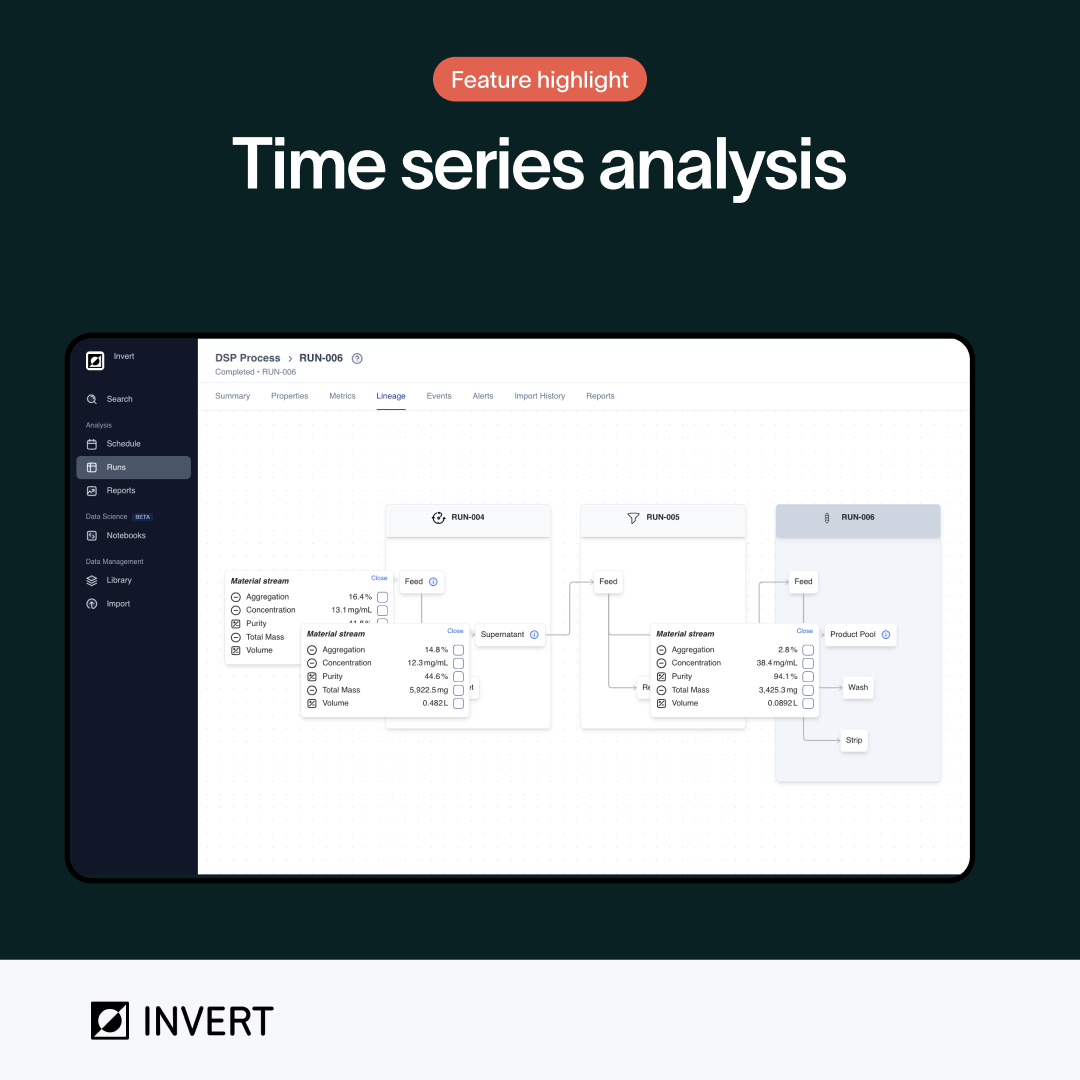Top AI Tools Powering the Future of Biomanufacturing (2025 Edition)

The Acceleration of AI in Biomanufacturing
Biomanufacturing has reached an inflection point. Rapid advances in process automation, analytics, and artificial intelligence are reshaping how therapies and sustainable products move from discovery to commercial production.
AI tools are no longer optional. They have become the core infrastructure that powers scale-up, process optimization, and manufacturing intelligence. Companies that once relied on spreadsheets and manual monitoring are now building digital ecosystems capable of learning, predicting, and adapting in real time.
But as the market expands, choosing the right platform becomes critical. Not all AI tools are built for the complexities of bioprocessing. Some focus on lab data capture, while others specialize in analytics or compliance. The best platforms are those that unify these functions to deliver trusted, live insights that directly impact product yield, quality, and time to milestone.
What Defines the Best Bioprocess AI Software
The term “AI in biomanufacturing” covers a wide range of solutions. To separate marketing buzz from true capability, leading organizations evaluate software based on five essential dimensions.
- Purpose-built architecture
The platform should be designed specifically for bioprocessing. Generic analytics or LIMS tools can visualize data, but they rarely understand the complex time-series relationships that define process behavior. Purpose-built AI platforms capture, harmonize, and contextualize that data in real time. - Trusted, AI-ready data foundation
The quality of insights depends on the quality of data. Top systems continuously ingest and harmonize information from instruments, sites, and CDMOs to build an accurate, contextualized foundation for analytics and machine learning. - Native intelligence layer
The most advanced platforms include real-time visualization, analytics, and transparent AI models within the product itself. This makes insights accessible without relying on separate BI dashboards or data scientists. - Fast, low-risk deployment
Biopharma cannot afford long IT projects. The best tools integrate through prebuilt connectors, often delivering value within days rather than months. - Compliance and traceability
AI in life sciences must operate under strict governance. Systems must maintain full traceability, data lineage, and audit trails that align with GxP and 21 CFR Part 11 requirements.
The Leaders Shaping Bioprocess AI in 2025
Below is an overview of several platforms most frequently discussed by process development and manufacturing teams heading into 2025. Each brings a different approach to the same challenge: transforming complex bioprocess data into actionable insight.
Genedata
Genedata is widely used for bioinformatics and R&D data management. Its Bioprocess platform provides structured data capture and reporting, particularly suited for upstream process development. However, its AI capabilities remain limited to statistical analysis rather than predictive modeling or live decisioning.
Bioraptor
Bioraptor offers data integration and workflow management tools for biotechs. Its strength lies in R&D collaboration and experiment tracking. For manufacturing-scale applications, it still relies on external analytics tools to achieve full process intelligence.
Scispot
Scispot focuses on modular lab data infrastructure, with strong capabilities in LIMS-like data capture and workflow automation. While flexible for startups, its architecture was not built for continuous bioreactor data streams or GMP environments.
Sigma Aldrich (Bio4C ProcessPad)
Bio4C ProcessPad from MilliporeSigma enables batch reporting and dashboard visualization for production environments. It supports real-time monitoring but depends heavily on manual configuration for new process types or instruments.
Invert
Invert’s Bioprocess AI Software represents a newer category: AI-driven manufacturing intelligence built for bioprocessing from the ground up.
The platform unifies fragmented datasets across instruments, systems, and CDMOs into a single, AI-ready foundation. On top of this trusted layer, Invert delivers a native intelligence environment with real-time visualization, analytics, and transparent AI.
This design allows scientists and engineers to monitor processes live, detect deviations early, and make confident decisions that shorten scale-up cycles and reduce wasted runs. Because deployment is fast and IT-light, organizations can start realizing value within days. Invert stands apart by combining data unification, live intelligence, and transparent AI in one purpose-built platform.
The Direction of AI in Biomanufacturing
The next generation of biomanufacturing intelligence will not rely on siloed dashboards or delayed batch reports. It will operate in real time, with AI models learning continuously from connected process data.
As companies build digital twins, automate tech transfer, and push toward lights-out biomanufacturing, AI will serve as the decision engine that connects science with scale.
To make this possible, bioprocess teams need a foundation that is unified, contextualized, and compliant. Tools that simply visualize data will give way to platforms that actively interpret it and recommend action.
Invert’s intelligence layer embodies that future, transforming live bioprocess data into clear, explainable insight that accelerates discovery and manufacturing outcomes.
What to Look for When Evaluating AI Platforms
When choosing an AI tool for bioprocessing, look beyond surface-level analytics or automation claims. Ask these questions:
- Can the platform integrate with bioreactors, historians, and CDMOs without custom coding?
- Does it harmonize and contextualize data automatically?
- Are AI models transparent and explainable, or are they black boxes?
- How quickly can it deliver measurable value after implementation?
- Does it ensure compliance with regulatory frameworks?
The answers will reveal which tools are future-proof and which may become limitations over time.
Building the Future of Bioprocess Intelligence
The evolution of biomanufacturing will depend on data that is both trusted and alive. AI is the engine, but unified data is the fuel.
The companies leading this transformation are not simply adding algorithms to legacy systems. They are rebuilding their digital infrastructure around intelligent, connected platforms that empower scientists, engineers, and quality teams to collaborate seamlessly.
The most successful organizations in 2025 will be those that bridge development and manufacturing through a single, AI-ready foundation.
That is the vision of Invert: to close the gap between data and decision, helping biopharma move therapies to market faster and more confidently than ever before.
.png)
Engineer Blog Series: From Bioprocess to Software with Anthony Quach
Welcome to Invert’s Engineer Blog Series — a behind-the-scenes look at the product and how it’s built.In this post, software engineer Anthony Quach shares how his career in bioprocess development led him into software, and how that experience shapes the engineering decisions behind Invert.
Read More ↗
Connecting Shake Flask to Final Product with Lineage Views in Invert
Invert’s lineage view connects products across every unit operation and material transfer throughout the entire process. It acts as a family tree for your product, tracing its origins back through purification, fermentation, and inoculation. Instead of manually tracking down the source of each data point, lineages automatically show material streams as they pass through each step.
Read More ↗
Engineer Blog Series: Security & Compliance with Tiffany Huang
Welcome to Invert's Engineering Blog Series, a behind-the-scenes look into the product and how it's built. For our third post, senior software engineer Tiffany Huang speaks about how trust and security is a foundational principle at Invert, and how we ensure that data is kept secure, private, and compliant with industry regulations.
Read More ↗